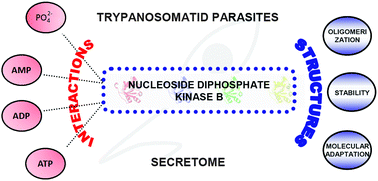Molecular adaptability of nucleoside diphosphate kinase b from trypanosomatid parasites: stability, oligomerization and structural determinants of nucleotide binding†
Abstract
Nucleoside diphosphate kinases play a crucial role in the

Maintenance work is planned from 09:00 BST to 12:00 BST on Saturday 28th September 2024.
During this time the performance of our website may be affected - searches may run slowly, some pages may be temporarily unavailable, and you may be unable to access content. If this happens, please try refreshing your web browser or try waiting two to three minutes before trying again.
We apologise for any inconvenience this might cause and thank you for your patience.
* Corresponding authors
a
Laboratório Nacional de Biociências (LNBio), Laboratório Nacional de Luz Síncrotron (LNLS), Centro Nacional de Pesquisa em Energia e Materiais (CNPEM), Campinas, SP, Brazil
E-mail:
tatiana.brasil@lnbio.org.br, daniel.trindade@lnbio.org.br, celisa.tonoli@lnbio.org.br, camila.santos@lnbio.org.br, mario.murakami@lnbio.org.br
Fax: 55-19-3512-1006
Tel: 55-19-3512-1106
b
Departamento de Química, Faculdade de Filosofia, Ciências e Letras de Ribeirão Preto, Universidade de São Paulo, Ribeirão Preto, SP, Brazil
E-mail:
rjward@ffclrp.usp.br, arthurdeoliveira@ffclrp.usp.br
c
Departamento de Física, Instituto de Biociências, Letras e Ciências Exatas, Universidade Estadual Paulista, São Jose do Rio Preto, SP, Brazil
E-mail:
arni@sjrp.unesp.br
Nucleoside diphosphate kinases play a crucial role in the

 Please wait while we load your content...
Something went wrong. Try again?
Please wait while we load your content...
Something went wrong. Try again?
T. A. C. B. Souza, D. M. Trindade, C. C. C. Tonoli, C. R. Santos, R. J. Ward, R. K. Arni, A. H. C. Oliveira and M. T. Murakami, Mol. BioSyst., 2011, 7, 2189 DOI: 10.1039/C0MB00307G
To request permission to reproduce material from this article, please go to the Copyright Clearance Center request page.
If you are an author contributing to an RSC publication, you do not need to request permission provided correct acknowledgement is given.
If you are the author of this article, you do not need to request permission to reproduce figures and diagrams provided correct acknowledgement is given. If you want to reproduce the whole article in a third-party publication (excluding your thesis/dissertation for which permission is not required) please go to the Copyright Clearance Center request page.
Read more about how to correctly acknowledge RSC content.
 Fetching data from CrossRef.
Fetching data from CrossRef.
This may take some time to load.
Loading related content
